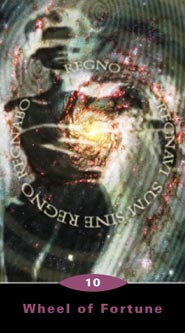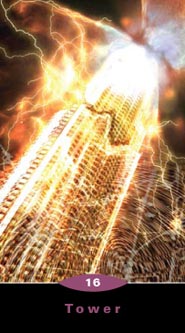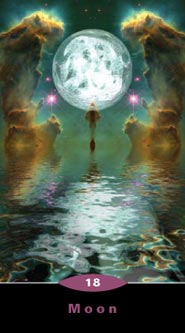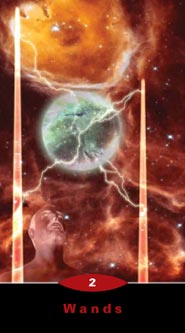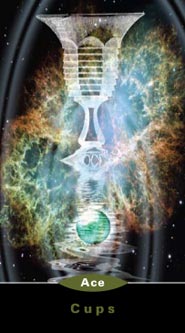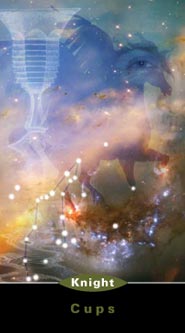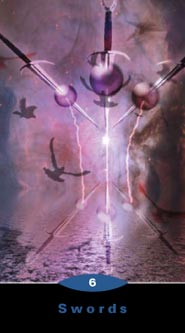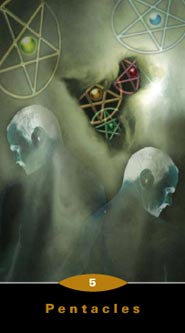Quantum Tarot Deck Review
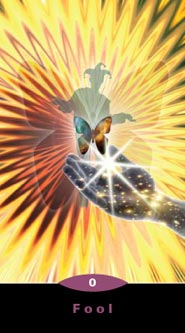
The Quantum Tarot combines modern theories of physics and quantum mechanics with tarot, through vivid space images from NASA and the Hubble telescope. The 78-card deck is a collaboration from Kay Stopforth and Chris Butler, who also created the 2nd edition of the Universe Cards. Previously released as a 78-card, borderless, gilt-edged edition from Kunati, it's now also been reprinted by Lo Scarabeo.
Deck Type: Tarot Deck Cards: 78
Creators: Christopher Butler, Kay Stopforth
Publisher: Kunati Inc. 2008
Retailers
See Price at Amazon.comSee Price at Amazon.co.uk
See Price at Amazon.ca
Quantum Tarot Review by Lee Bursten
My curiosity to see what the creators of the Quantum Tarot had come up with was greater than for any other deck in recent memory. I’ve always been intrigued but baffled by quantum theory and modern physics in general, and reading such books for laymen as Fritjof Capra’s The Tao of Physics and Walter Isaacson’s Einstein: His Life and Universe, have only served to increase my interest (and my incomprehension).
It’s a core belief of mine that tarot is an art form, albeit a highly structured one, like Shakespearean sonnets or pop songs. While they must adhere to specific conventions, such art forms should theoretically be capable of addressing any subject at all. So, why not quantum mechanics?
Author Kay Stepforth deserves much credit for conceptualizing this fascinating idea, for the accompanying book she has written, and for the cards which she and artist Chris Butler have created. I’m envious of her skill in coming up with 78 cards which each relate to an aspect of quantum physics while simultaneously reflecting traditional tarot archetypes.
The Majors each reflect major themes and theories of quantum mechanics. For example, the Magician symbolizes electromagnetic force, the Lovers represents Newton’s theory of gravity, and the Star illustrates string theory. Kay did a great job in assigning Majors to forces and theories. These assignments are somewhat personal and arbitrary – and this isn’t a criticism; it’s necessarily true of any “theme” deck. I found that most of Kay’s assignments made complete sense to me. I particularly liked the use of various aspects of gravity for three cards (the Empress, the Lovers, and Strength); the Big Bang theory for the Fool; Planck’s constant for Justice; the uncertainly principle for the Hanged Man; black holes for the Devil; and the ever-elusive Theory of Everything (“the physicist’s Holy Grail”) for the World. The assignment of the Hierophant to Newton’s laws of motion is brilliant (as is the image, which shows a portrait of Newton in negative, hovering over a solar system). Newton’s laws typified the mechanistic worldview which was shattered by quantum physics.
Interestingly, for some of the Majors, the theme of the card isn’t so much the theory itself but rather the effect that theory has had on the scientific community and society in general. For example, the supersymmetry theory is assigned to Temperance, not because of any particular Temperance-like attributes of the theory itself, but rather because it attempted to reconcile two previously incompatible theories (Einstein’s theory of gravity and quantum theory). Likewise, the Star is assigned to string theory because it tries to reconcile general relativity with quantum theory, thus providing “real hope for a more integrated understanding of our universe.” These assignments seemed more of a stretch to me; I found I preferred the cards which had more of a direct relation between the tarot archetype and the theory or phenomenon they were assigned to.
The numbered Minor cards are little miracles of insight and organization. I never would have thought it possible to find so many clever and apropos card assignments based on astronomical and quantum phenomena, while adhering to Rider-Waite-Smith conventions, but Kay has done it. For example, for the celebratory and companionable 3 of Cups we have star clusters; for the tricky 7 of Swords, radiation; for the dexterous 2 of Pentacles, subatomic particle spin. The numbered Minors will provide fascinating new viewpoints on the RWS pattern, a pattern which has grown perhaps too familiar to many readers.
With the Court cards, Kay examines mythological personalities embodied in planets and constellations, in a manner somewhat similar to the Mythic Tarot. Because the Quantum Tarot Courts refer to specific mythic characters with their own personas, it’s easy to immediately grasp the significance of the card, as opposed to other decks or interpretive systems where we’re simply presented with a collection of attributes to be memorized.
The book includes four spreads, a standard three-card spread and three new spreads with card positions suggestive of the modern physics theme, including such positions as “Wave” (“how the situation affects you emotionally”) and “Particle” (“how the situation affects you practically”). These spreads were fun to experiment with for readings, and they suit the cards well. I only wish there had been room for a sample reading.
I’ve always been a fan of Chris Butler’s art, and in this deck Chris’s cosmic style finds a perfect environment in which to flourish. It’s been a particular joy of mine to watch Chris’s tarot art deepen in technique and sophistication, and in the Quantum Tarot it reaches new peaks, with startlingly creative nuances of shade, texture and detail. I was impressed with how well the card images illustrated the applicable concepts. Several of the Major cards are breathtakingly beautiful, including the Fool, the High Priestess, Justice, Temperance, the Devil, and the Moon. Minor cards I particularly liked include the Ace of Wands, 3 of Wands, 4 of Cups, Knight of Cups, 10 of Pentacles, and all the Pentacle Courts.
I love how the human form is depicted on the cards in a variety of styles. In some cards we see a clear and distinct photograph; in others, the details are obscured or hazy; and in still others, we see only silhouettes. Particularly entrancing are those cards in which there is no distinct human form, but the stellar elements themselves suggest human forms, such as the High Priestess, a star-forming pillar of gas and dust which suggests a veiled human figure, and Temperance, in which the empty space between star-clouds seems to coalesce into two winged figures facing each other, holding vessels. Personally, I found I preferred those Majors that showed silhouettes, heavily manipulated photographs, and natural formations, as opposed to the Empress, which shows a straightforward photograph of a woman. On the other hand, I felt the more distinct photos worked well for the Court cards.
I have to make special mention of the Star card. A strikingly beautiful card, it shows the standard female figure pouring two streams into a body of water. The only light in the card comes from the stars themselves, behind the figure, so that her features are completely in shadow. It’s a dark, murky, lovely, startling image. This card and the Haindl Tarot’s Star are my two favorite Star cards ever.
The publisher, Kunati Inc., has done a wonderful job with the physical production. The deck, book, and box are all the same size, forming a sturdy package similar to that of the Golden Tarot. The book is small but chunky at 200 pages and includes full sources and credits for the images, so that those who wish to can research the images further. In an ingenious move, the edges of the deck are “gilded,” not with gold ink but with silver, giving the deck a unique high-tech shine. The cards are well-made, with gloriously bright colors and a matte finish. Personally, I would have preferred to have the descriptive card titles from the book printed on the cards (for example, “2 Swords – Dark Matter” rather than simply “2 Swords”). Being able to see the descriptive titles on the cards would have helped the reader to remember the scientific background of each card while performing a reading.
On a personal note, this is my last tarot review. Changing circumstances and changing interests are whispering to me that it’s time to close this chapter of my life. It’s interesting for me to look back at my first review, for the Aquarian Tarot, written ten years ago, and compare it with this review. The Aquarian Tarot, published in 1970, was an innovative deck at the time, but seen from this vantage point, 38 years after its creation, it seems somewhat backward-looking, its inventiveness centered mainly around decorative aspects. I see the Quantum Tarot as very much a forward-looking deck, for several reasons, including its innovative concept, its mind-expanding art, and its technological and futuristic theme. As such, the Quantum Tarot is the perfect deck with which to end my tarot-reviewing career. As I close the door on tarot reviewing, Kay and Chris have opened a door onto new tarot vistas. I congratulate them, and I hope other deck creators will follow suit.
Quantum Tarot Review by Bonnie Cehovet
The “Quantum Tarot” is quite a unique Tarot deck, in that it combines the 78 card structure of the Tarot with the revolutionary theories of 20th century physics, including Quantum mechanics, Einstein’s theories of relativity, and the superstring theory. Through the Tarot, we see these theories function in two extreme worlds: the vast expanse of the universe, and the invisible world inside the atom.
Originally published by Adam McLean as a 22 card Major Arcana Limited Edition deck, the full 78 card version from Kunati Press is a stunning work that will open minds and express the energy of the Tarot in a whole new manner. The box is sturdy cardboard, with a lift off top. The companion book is 199 pages, with black and white scans. The deck is the traditional 78 cards, 3” by 4 ľ” , quality card stock, with stunning gilt edges.
In his foreword, Chris Butler, artist for the “Quantum Tarot” talks about this project as being one of those that you “ know immediately that you have to work on”. I felt that with this deck there was a great symmetry between the spoken word and the artistic symbolism – that the author and the artist were on the same page at the same time, and that the result was stunning (to say the least!).
The “point of departure”, as it were, for this deck was the use of Hubble Space Telescope images as primary source material. This worked so well that I, for one, would be very surprised if most people viewing this deck did not hear the Star Wars theme in their mind! Each card draws parallels between either scientific theory or the ancient myths behind the planets and constellations. Butler and author Kay Stopforth did an amazing job – the first draft of this deck was done over a three-month period.
In her introduction, Stopforth notes that her motivation for creating this deck was to incorporate the colliding of galaxies (or subatomic particles) into a divination system. Her vision for the “Quantum Tarot” is that it act as a doorway for laypeople into this complex, bizarre world.
In this deck, the Major Arcana deal with theories of modern physics (including string theory and M-theory), explaining how they impact our world. The Minor Arcana explore the universe and the atom, through such phenomenon as nebulae, galaxy collisions, neutrinos, antimatter and particle decay.
The Court Cards take a new look at familiar mythic archetypes from the night sky throught he lens of science. The text for each card includes an explanation of the theory, a summary of the cards symbolic meaning, and a question to help the reader understand the information in a personal manner.
The great thing with this deck is that because it is based on traditional Tarot structure, anyone with a Tarot background will be able to immediately read with this deck. The spreads included with this deck include a three-card spread, a four card Relativity spread, a five card Uncertainty Principle spread, and a seven card Quantum Pathway spread.
Each card is presented with a black and white scan, traditional card title, and a sub-title of the theory/energy being presented. There is a discussion of the scientific background for the card, an interpretation of the card, and a question that the Seeker asks themselves about the card in relation to their life. For instance, The Fool is sub-titled the Big Bang, the interpretation is that the Fool represents and state of absolute newness. The butterfly symbolizes the newly created universe, with the Fool having no fear, no experience, and being unaware of any dangers lurking in the shadows. The question that the Seeker needs to ask themselves is “What new beginning are you about to embark upon?”
The Minor Arcana is presented in the same format – black and white scan, traditional card title, with a sub-title of the energy being presented. There is a discussion of the scientific background for the card, an interpretation of the card, and a question the Seeker needs to ask themselves to place the energy in their life.
The Court Cards follow the same format – black and white scan, traditional card title, a discussion of the scientific background, interpretation of the card, and a question the Seeker needs to ask themselves to place the energy in their life. The sub-titles for the Court Cards reflect figures from mythology, or planets. For instance, the Queen of Pentacles is sub-titled Earth, while the Knight of Swords is sub-titled Herakles/Hercules.
At the back of the book is a comprehensive listing of image sources and credits for each of the cards.
The cards themselves are absolutely stunning! I love that the imagery goes to the edge of the card – there are no borders. Each card has a black strip on the bottom, with the card title and number across the strip. The small area that the number is in is color coded – the Major Arcana is purple, Wands are a brownish-red, Cups are green, Swords are blue, and Pentacles are gold. The backs of the cards are purple, with gray/white highlights, showing a galaxy-type formation. The backs are reversible.
The Fool is presented as a hand, coming from the right hand side of the card, with a white star in the middle. Above the hand we see a butterfly, with a gray “juggler” form behind it. The background is done in a brilliant yellow and dark red-orange.
The Empress totally pulls the reader into the card, making use of purple coloring, a female face superimposed on the left-hand side of the card, with the symbol for Venus in the upper right-hand side of the card. In the Chariot, we see Einstein’s face in the upper right hand side of the card, with glowing gold under it, and E=MC2 across the bottom of the card.
Death shows two skeletons facing each other, with hearts, butterfly’s, and the symbol for the galaxy between them. The World shows a hand coming from the right hand side of the card. Floating above the hand is a clear bubble with a dancer in the middle. A rainbow is shown both above and below the floating bubble.
The presentation of this deck and companion book exemplifies quality, and the artwork and text follow suit. The feel of each card is that of experiencing an intimate part of the vastness of space. Symbols and figures superimposed over the Hubble images are awe inspiring, and thought provoking. The Minor Arcana show some figures, but no “scenes” (note: there are also no scenes per se in the Major Arcana). All swords are straight, as opposed to those decks that used a curved sword for the odd numbered sword.
I found this deck to be a collectors item, certainly, but I also feel that it is very easy to read from, and would be an interesting deck to present as a choice for clients.
Quantum Tarot Review by Nisaba Merrieweather
The Quantum Tarot was conceived by Kay Stopforth and illustrated by Chris Butler, and was published by "Kunati Inc" in, I think, China. The unbordered deck is printed on good-quality, sturdy cardstock, and its edges have been silver-gilded. It is presented in a sturdy box with gorgeous art smeared around it, that also comfortably houses the LWB, which is not L and not W either, but slightly too small to be considered a "companion-book". When it arrived at my door, it arrived in the company of another gold-gilded deck, more than doubling the number of decks in my collection that had decorated edges. I unwrapped it second, and as the silver came out, I was quite unreasonably thrilled by it: it seemed perfect for a science-themed deck, and it certainly was perfect for the tonal range of colour in the deck.
There is some product wastage in this deck, which I viewed with a little distaste: the entire bundle was shrink-wrapped, and when I opened it, the inner deck was also shrink-wrapped. This to me seemed like a waste of fossil fuel by-products as well as creating an unnecessary disposal problem. One or the other level of shrink-wrapping could well have been dispensed with. It didn't take me long to add to the world's pollution problems by disposing of both layers of shrink-wrapping thoughtlessly in landfill.
The deck turned out to be a joy and a delight, and I was immediately glad that I had decided, on impulse and sight-unseen, to buy two copies rather than one, and gift one to an ex of mine.
As I said, this is a solidly science-based deck. All my life I've been a humanities-based creature: my selection of subjects in high school was humanities-heavy (in the late seventies I matriculated with good results in 3-unit English, 3-unit Ancient History and 3-unit music). Towards the end of the eighties I started watching shows like "Quantum" (yes) and "Catalyst", and reading pop-science, which was starting up a literary genre around the same time. I vividly remember and still have my first pop-science book: it was Gary Zukav's "The Dancing Wu Li Masters", in which he explores the fizzing world of quantum and the enfolded universe. In the early nineties I established a long-term live-in relationship with an out of work physicist (at least, not working in the field) and it was then, over conversations, idiot-questions and sometimes quite strident arguments, that I picked up painfully a little science.
Some physicists use particle accelerators, some mystics use Tarot decks. Both physicists and mystics are asking questions about the really big, important things in the universe, and in cases like that partner, one body of knowledge deepens and enhances the other. So of course I was always going to get myself this deck, and of course I was always going to get another copy for that particular ex-partner. I could not have done otherwise. I was glad, then, that Kay's intelligence in deck-design did not let me down, and that Chris' skill with photo-collage and visual things in general was so high and so seamless.
Each card has a traditional Tarot name and traditional number printed on the card, and does, in fact, deal with traditional energies and concepts, but this is where reference to the past begins and ends. All of the cards have a scientific concept associated with them, which often can really only be accessed by referring to the booklet. At this point, it is worth mentioning that "Quantum" is a bit of a misnomer: the quantum end of things is the realm of the very, very small, and this deck deals both with the very, very small and the very, very large - quantum physics and astrophysics. "The Quantum Deck" is much more musical, however, than "The Physicists' Deck", and I am completely okay with her naming it that way.
The basic visual language of the deck is the visual language of Hubble Space Telescope photos: Chris must have pored over them, studied them, and incorporated their "look" into every single design except "The Fool" which to my eye is the least successful card in the deck. So let's look at a few cards as examples, and as I've already mentioned it, The Fool is an obvious first contender. As the Fool represents the beginning of the journey of human growth and development, Kay fittingly decided on "The Big Bang" as its scientific assignation. A yellow, triangular, disappointingly cartoon-like explosion fills the card. A large, shadowy hand with sparkles on it nurses the white star-like core of the explosion. Two concentric butterflies, one just hinted at, are just above and around the hand, and behind them the figure of a traditional court jester in mid-juggle, with his triple-horned hat. The jester works, The butterflies as a symbol of transformation work. The hand works. The jester in the background works. Unfortunately, the yellow explosion really doesn't work.
The Five Pentacles, by comparison, works. Most of the Pentacle cards are tinged with green to symbolise their symbolic connection with nature and the material world, and this is no exception. Two green-black figures in postures of defeat stand back to back. The blackness of space is overlaid with a gaseous cloud that is greenish in its lighting, and has a torn section shaped like a human head and shoulders out of which five pentacles with circular insets in their centres come tumbling. The scientific concept associated with this is the lepton, and there is a nice little discussion of neutrinos and quarks, neutrinos free to wander at large and quarks tied in and limited, which well suits the limitations of choice that this card traditionally suggests.
The Ace Swords is subtitled W and Z Bosons, and shows a glowing sphere resting on the hilt of a sword against a flooding nebula, a flash of lightning striking diagonally across the card and the sword. The Weak Force, mediated by these particles, changes matter from one state into another, and the Ace of Swords symbolises the developing power of the mind to change one state of being into another.
The Ten Cups shows ten translucent cups floating in space at various distances from the observer, a spiral galaxy (its scientific subtitle) upright in the background, with rainbows bouncing through the glass of the Cups. It is an aesthetically very pleasing image, and the idea of a whole galaxy on the card fits in very well with its meaning of "having it all".
The Page Wands shows us the shadowy figure of a youth pulling back a longbow, and at the bottom of the deck a starmap picking out the constellation of Orion, the only constellation I could recognise at first sight through all of my childhood. I have a great fondness for the Great Hunter - he has followed me through the night-sky for decades. The whole card flickers with flame, as befits a Fire card, and through the youth's shoulder and wrist of the extended arm are just visible the eyes of a quiescent, watchful face layered below these other aspects of the image. Is he the older Orion, the King, watching over the Page's youthful attempts to act like a grown-up, remembering his childhood? Like all the cards in this deck the image is built up in layers, and like all of them, too, the meanings are just as layered and complex.
Last of the cards I will discuss today is the Hierophant. A card of a teacher and the holder of society's inherited wisdom, we see a cross-hatched portrait of Newton, yes, old Isaac himself, sitting over a boiling sun which is ringed with the orbits of the planets, and his left hand is casually toying with Saturn's orbit, which is interesting, as Saturn, too, has the suymbolism of a teacher around him. Crossed translucent keys complete the image whose science subtitle is Newton's Laws. This is appropriate: Newston's three laws have been the basic foundation of science for centuries, and in many applications are still useful and used - the teachings of the past brought into the present, which is just what a traditional Hierophant is meant to suggest in any Tarot deck.
In this deck, the Hanged Man is one of my favourites, for largely visual reasons. It is a Hubble Space Telescope type image of two gaseous clouds or nebulae colliding, and the space between them picks out in darknes the traditional shape of a body suspended by one ankle, the knee of the other leg bent, the arms behind the back. An explosion of light, perhaps a supernova or perhaps something entirely different, is happening just below the shadowy head, lighting up the lower surfaces of the clouds. The whole image has equations written all over it in fine, pale handwriting, which would probably make sense to somebody other than me.
This deck is visually lush, completely workable in terms of traditional Tarot usage, and is exciting because it blends the "far left" of mysticism with the "far right" of science, resulting in a more balanced understanding of the larger world-picture than either side can hope to achieve alone. I anticipate a long and happy association with it.
Complete Details of Quantum Tarot
Creators: Christopher Butler, Kay StopforthPublisher: Kunati Inc. 2008
Deck Type: Tarot Deck
Cards: 78
Major Arcana: 22
Minor Arcana: 56
Deck Tradition: Modern
The Fool is 0
Strength is 8
Justice is 11
Card Language: English
Card Back: Unknown
Rating: 16/20 or
Similar Decks to Quantum Tarot
Theme: ScientificCategory: Borderless Tarot Decks
Creator: Quantum Tarot, Quantum Tarot: Version 2.0, Universe Cards, Universe Cards (2nd ed.) by Kay Stopforth Butler Tarot, Greylight Tarot, Healing Light Tarot, Le Millenaire Tarot de Marseilles, Lenormand Cartomancy, Quantum Tarot, Quantum Tarot: Version 2.0, Son Tarot, Technoracle, Universe Cards (2nd ed.) by Christopher Butler
< Previous Deck · Back to Top · Next Deck >
Home > Tarot Reviews > Quantum Tarot Review

